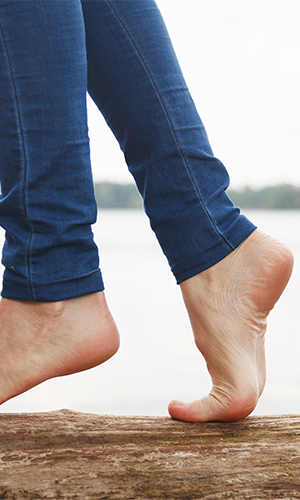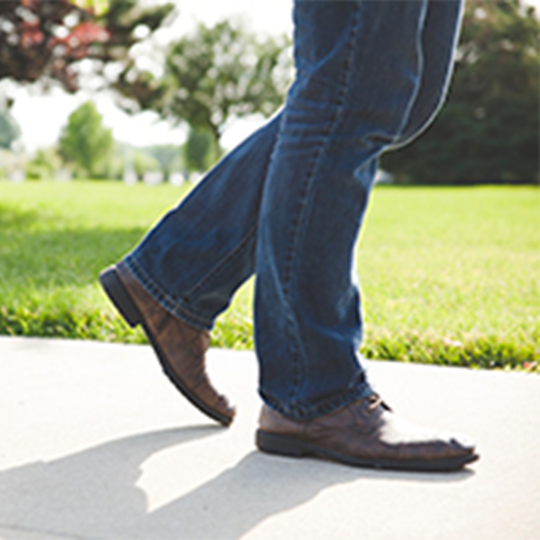Our feet are the basis of the body and get to daily strain in order to cope with everyday life. Nevertheless, we often ignor them! But what would we do if we no longer had a good and stable stand or if our toes could no longer keep our balance?
The feet are a true architectural wonder. They consist of 26 bones, 100 ligaments and tendons, 2 dozen of muscles and a total of 33 joints. But due to our monotonous everyday stress, they are unfortunately also a part of the body that causes problems for many people. Since the health of the feet also affects the health of our knees, hips and spine, we should pay more attention to them.
For example, our toes should be able to move independently from each other and from the rest of the foot. But who can say that they can stretch or claw the little toe into the air independently of the four others?
Problems with our musculoskeletal system often result from our habits – the way we move, or in the case of our feet, especially in what we move.

Our feet are a true architectural wonder and can perform many more movements than we give them credit for – but they are usually ignored in everyday life!
Shoes or barefoot?
What is good for our feet?
We grew up in shoes and wear them every day – for a lifetime. That is why we rarely think about the fact that shoes are not only beneficial, but also offer some challenges for the body.
When it comes to healthy feet, we cannot help but take a closer look at our shoes. After all, the biggest influence on the condition of our feet beside our own style of movement, are our shoes.
The structure of the feet suggests that they could be very flexible – but they are enclosed by fixed, inflexible footwear and thus directly influenced in their functions. Furthermore, the biomechanical properties of the shoes change not only the feet but also the geometry of the entire body.

High heels illustrate this aspect in the best way. Scientific studies show that wearing heels permanently can lead to problems at our feet, ankles, knees, hips and spine. The body reacts to the unnatural position of the feet by compensating in other areas of the body.
Since shoes are such a decisive factor for the health (of our feet), it makes sense to learn about the characteristics and structure of footwear and their effects on the body. You will also find a few points you should have a closer look at your shoes so that they do not affect your foot health.
Footwear consists of these four main components:
Shoe sole
It protects the skin from abrasions or wounds. The bottom of the shoe (the sole) varies in terms of stiffness, thickness, softness, footbed characteristics and height. Each criterion can influence which muscles are activated when walking. The sole also adapts to fashion – from healthy functionality to absurd heights, lengths, etc.
Effects on feet and body: The protection leads to limitations in sensitivity and mobility. The blood flow of the sole of the foot is reduced, which normally in turn strengthens the muscles, bones and skin of the feet and lower legs.
Pay attention to the following when wearing shoes: The sole of the shoe should be thin and flexible (however, thicker is better than rigid).
Upper of the show
It is the uppermost material layer of the shoe and holds the sole to the foot. Its properties are determined by the amount and type of material covering the skin. (ankle-high hiking shoe vs. thong sandal)
Effects on feet and body: If the shaft is very low (e.g. thong sandal), the toes have to grab on tight, especially if the heel strap is missing. There may be a risk of forming a hammer toe.
Pay attention to the following when wearing shoes: The shaft should provide good support. When wearing sandals, pay attention to the heel straps, it is better to avoid backless slippers or thong sandals.
The front part of the shoe
There are two criteria for its construction: the width and the distance between the floor and the tip of the shoe. Width: the forefoot and toes (tissue and bones) must fit completely into the front part of the shoe (=forecap). The front part of the shoe should rest on the ground, just like the forefoot. However, at some point manufacturers have developed shoes where the front part is raised. Today’s form of the toe cap (narrow cut) is only a design element and has no function.
Effects on feet and body:Tightly cut shoes prevent the toes from spreading. If toes are permanently compressed, the musclesbecome weaker. Joints and bones are more stressed in this malposition.
Pay attention to the following when wearing shoes: They should provide complete freedom of movement for the toes. Avoid squeezed toes at all costs. The toecap of the shoe should lie completely on the floor and not be bent upwards and/or rigid.
Heel
It is the most important part of the shoe and is located just below the heel of our foot. The heel completely changes the geometry of the body. Even “normal” shoes have a raised rear part. This is because as soon as the heel is higher than the rest of the foot, we speak of a “plus heel”. This definition covers, for example, business shoes, both for women and men, and even running shoes.
Effects on feet and body: There is a proven link between wearing shoes with heels and foot, knee and back pain. Even a low heel of 2-5 cm can tilt the body forward by many degrees along its entire length. The forward tilt caused by a heel is compensated. The extent of compensation is very individual and is possible through the position of the ankle joint, movements in the knees, tilting of the pelvis or spinal curvature. Furthermore, the pressure on the forefoot increases.
Pay attention to the following when wearing shoes: It is best if the shoe has no heel. (Still acceptable: less than 0,6 cm). Avoid heel heights of 2,5 – 5 cm and more.
We usually buy our shoes according to the occasions we wear them. Appearance is often the most important factor – not necessarily the effect on foot health. However, knowing the interaction between the different parts of the shoe and various aspects of foot health, you should do something good for your feet the next time you buy shoes and choose an alternative that is healthier for your feet.
Shoes for the office:
- Do regular exercises to stretch and strengthen your feet (muscles, tendons, fascia).
- Make sure that the shoes you wear outside the office are without plus heel. For example, choose a flat sports shoe to improve the function of your feet when you train or go for a walk.
- Place a pair of flat shoes in the office.
- Integrate small foot exercises into your daily work routine.
- wear toe spreaders (toe socks) after work.
- Cushioned mats – provide absorption and an unstable surface on which balance must be constantly maintained – activates the muscles in the feet (caution with tissue that is too soft). Also known as anti-fatigue mats. These mats can be used barefoot, with socks or with shoes and can also be used in the office.
- SMOOVE Mat by Blackroll
- has a pressure-relieving surface which offers a variety of standing positions
- Special feature: integrated fascial tools (Blackroll mini, Ball and Twister) for self-massage and stretching
- This mat encourages more activity
Nevertheless, wearing shoes remains an unnatural habit from a biological/anatomical point of view – because of that the rule is: take off your shoes as often as possible and walk barefoot.
Why walking barefoot is important:
The different part of the foot are strained differently when walking barefoot than while wearing shoes, as the comparison between barefoot walkers and shoe wearers shows:
On the left: Barefoot walkers who never wear shoes (BI); middle: mixed form, mostly barefoot, partly shoes (SI); right: shoe wearers from western countries (W)
You can see the pressure distribution when walking barefoot. According to the study, it could be shown that our behavior regarding wearing shoes influences the form and function of the foot.
Our feet are designed to absorb and release energy through the heel, metatarsus, big toe and the body’s own damping system of fascia and muscles. Thick soles, however, change this function, so that the tissue degenerates and over-stimulated. Compensatory postures and strains take a “break” when walking barefoot.
The function of the big toe also gets better when walking barefoot: with every step, it works as an important stabilizer and ensures balance. However, this only works if it can spread out, just like all other toes. Barefoot runners therefore have significantly wider feet, whereas our (western) foot shape has adapted to the tightly fitting shoes.
In addition, the sole of the foot is activated when walking barefoot. Walking on natural surfaces such as sand, meadow or forest floor stimulates the blood circulation. The proprioceptors (measuring sensors in tendons, muscles and joints) receive additional stimuli and the foot muscles are trained in a natural way.
Our feet need exercise to stay healthy. Therefore, walking barefoot or walking and training without shoes is a good way to train your feet.

The most important thing is that you slowly build up barefoot walking. Compare the time you have worn shoes in your life with the time it may take to walk barefoot for an extended period of time without risk. However, always give your feet a break by taking off your shoes and socks and running barefoot or doing some exercises.
The health of the feet affects the health of the whole body – so you should start training for healthy feet right away.
The best way to train your feet while working is to take off your shoes and work barefoot while standing!
Literatur:
- D’AoÛt , T.C. Pataky , D. De Clercq & P. Aerts (2009): The effects of habitual footwear use: foot shape and function in native barefoot walkers , Footwear Science, 1:2, 81-94
- Bowman (2017): Gesunde Füße – step by step. Rücken-, Hüft- und Knieschmerzen vermeiden, Hans Nietsch-Verlag




